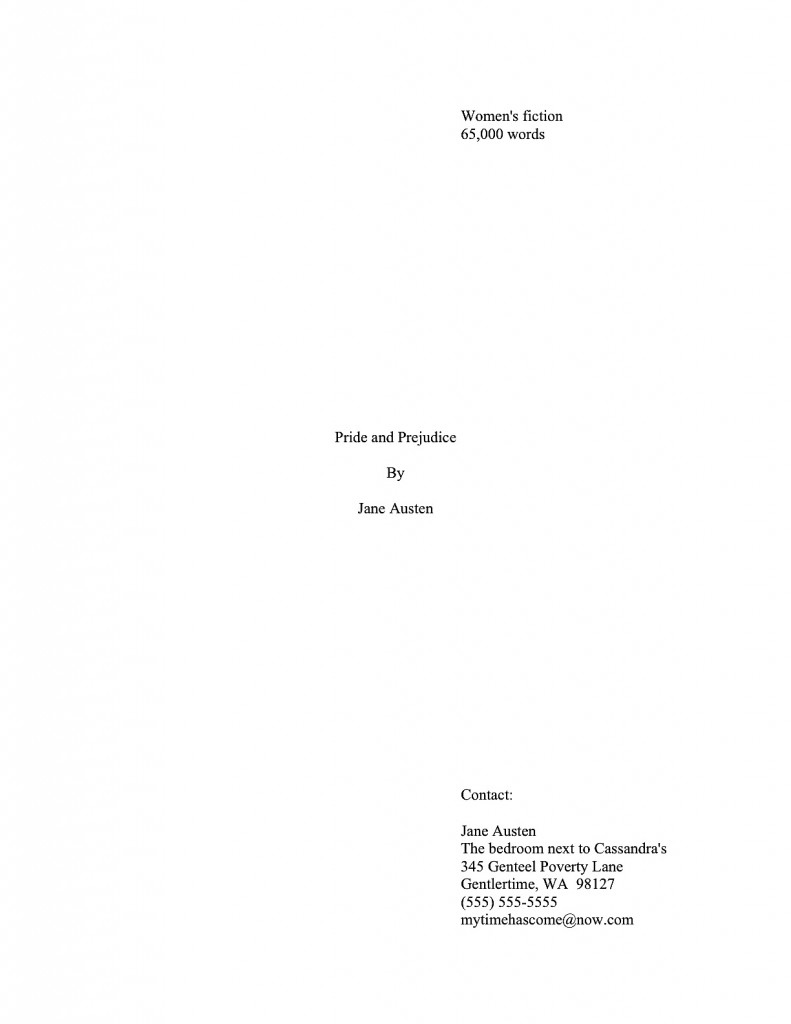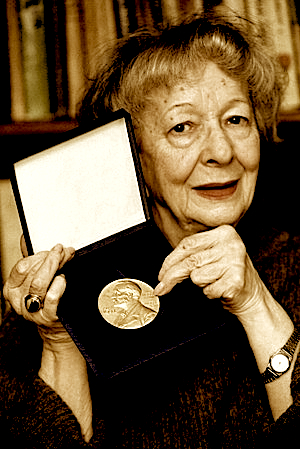
Before I begin today, a brief word to the silly people who keep posting parts of readers’ old comments as fresh comments, in an attempt to imbed links on this site: first, you’re assuming that I won’t remember the real comments from the first time they posted; I do. Second, if you’re trying to trick me into letting ‘em by, you might want to avoid using comments I posted myself.
Seriously, this has happened 50 times over the last couple of days. So if you see your own comment showing up twice, let me know that one got through my shielding.
But enough about stupid marketing tactics for today. Let’s talk about some smart ones. During our recent discussion of Point-of-View Nazis and their narrative-limiting ways, reader AM made a great suggestion:
Now what we need is your take on writing a query letter for a multiple POV novel. Or maybe I just need to find an attractive combination of money and chocolate bribe to get your input on mine. Hmm.
See, spam marketers? There is a polite way to get my attention. Now if I can make my way through this roomful of bundled dollar bills and baskets of truffles, I’ll get right to AM’s perfectly reasonable request.
Just kidding. I don’t like chocolate all that much.
What AM is talking about, of course, is not the entire query letter, but that pesky paragraph where the aspiring writer attempts to give some indication of what the book is about. You know, the second paragraph of a standard query letter, or the third paragraph of this one:

There’s a reason that lovers of multiple-protagonist stories find constructing that paragraph frustrating, and a darned good one. Let’s face it: that’s not a lot of space to talk about a perfectly straightforward boy-meets-girl story, let alone one following five protagonists, seventeen subplots, and fourteen generations of bunnies on an epic trek across four continents.
So I’ve got a radical suggestion: don’t try.
I’m quite serious about this. Instead of attempting to force a super-complicated plot into the space of a scant paragraph, just show enough of the premise to intrigue Millicent the agency screener into asking to see the manuscript.
Which is, after all, the actual goal of any query letter or pitch, right? I said: right?
If you didn’t respond immediately in the affirmative, you’re not alone. Most queriers and pitchers new to the game assume, wrongly, that if only their query or pitch is good enough, an agent is going to say yes on the spot. Since that literally never happens — no agent in his right mind would agree to represent a manuscript or book proposal he hasn’t read, unless it was written by someone who is already a celebrity in another field of endeavor — and the assumption renders the hard process of coming up with that descriptive paragraph even harder, the sooner an aspiring writer can jettison it, the better.
Is that dangerous notion out of your system? Excellent. Embrace this much more workable principle instead: the point of the descriptive paragraph in the pitch is NOT to distill the essence of the book; it is to convince the agent or editor to ask to READ it. Thus, your job is not to summarize the plot, but to present it in a fascinating manner.
Again, this is a tall order, even for a novel focusing on a single protagonist. Within the space of a paragraph, it’s genuinely difficult to make someone sound like an interesting character in an interesting situation. Generally speaking, your best bet is to focus on what’s most unusual about the protagonist and/or the situation.
Don’t believe me? Okay, if you read as many queries as Millicent, which would intrigue you more:
an accountant confronted with an ethical dilemma , or
a goose-loving accountant forced to decide between betraying his parfait-scarfing boss and being kidnapped by a mob of crazed azalea gardeners?
One’s generic; one’s fresh. Or, to put it querying terms, the second one is far, far less likely to make Millicent roll her bloodshot eyes and mutter, “Oh, God, not another accountant in a dilemma story. Just once, I’d like to see one of ‘em do the wrong thing.”
Okay, okay: so that’s a pretty jaded response. And the second presentation’s details are a little weird. But it caught your attention, didn’t it?
Those of you writing about multiple protagonists are scratching your pretty little heads right about now, aren’t you? “But Anne,” these sterling souls inquire politely, because they know that’s the best way to get me to answer. (I’m looking at YOU, prose-stealing spammers!) “That sounds like great advice, but how does that apply to my novel? All seven of my protagonists are interesting people in interesting situations, but there just isn’t room in a 1-page query letter to introduce them all that way. Help!”
Superlative question, head-scratchers. In theory, a good multiple-protagonist novel is the story of LOTS of interesting people in LOTS of interesting situations.
That can make a great read, but it definitely presents a space-usage problem in a query letter. Take, for example, what the descriptive paragraph of John Steinbeck’s East of Eden would look like if Uncle John were (a) querying it today, (b) not already famous by the time he wrote it, and (c) he didn’t already know that the manuscript’s first 10 pages being almost exclusively concerned with the soil conditions of the Salinas Valley would probably lose Millicent pretty quickly:
Adam Trask and his brother Charles have a problem — and not just that their father has built a career on lying about his experiences in the Civil War.
Allow me to pause there for a moment: the story’s grabbed you already, hasn’t he? See what I mean about the hook value of unusual details?
But let’s assume for the purposes of argument that Millicent hasn’t already e-mailed him and asked to see the manuscript without reading the rest of the letter. (Hey, she’s busy; she already knows she wants to see it.) See how the energy fades as the description piles on more and more protagonists:
Adam Trask and his brother Charles have a problem — and not just that their father has built a career on lying about his experiences in the Civil War. For reasons Adam is powerless to explain, insensate rage overcomes Charles anytime their overbearing father shows so much as a flicker of preference for his brother. Sent off to the Indian Wars against his will, Adam loathes killing the innocent; Charles, deserted at home, farms and longs for his brother’s return. Meanwhile, wee sociopath Cathy Ames blithely leads young men to their doom in her home town. After a young teacher kills himself for her sake, her parents attempt to curb her — such a pity that they underestimate Cathy’s familiarity with kerosene. Out in California, Samuel, a family patriarch who bears a suspicious resemblance to the author, proves himself incapable of making money, but is the most respected advice-giver in the whole Salinas Valley. Samuel is the first to notice that Lee, Adam and Cathy’s hired hand, loses his pidgin accent as soon as anyone speaks to him intelligently. After Cathy unwillingly gives birth to twins Cal and Aron, she flees to Faye’s house of ill repute. Trusting Faye comes to love Cathy — now calling herself Kate — like a daughter, unaware of how the young woman has historically treated her relatives. The Sheriff of Monterey County worries about Kate and Adam, but can do little as she builds her business. As the Trask boys grow, secure in Lee’s love and Adam’s depressed indifference, three of Samuel’s children have their own individual adventures. Abra, a beautiful young girl visiting the Trasks with her parents, is charmed by eleven-year-old Aron’s beauty, but repelled by Cal’s rudeness.
That’s not the plot, mind you — that’s just a basic list of the protagonists and their initial conflicts. And I haven’t gotten to the part where the James Dean film version of the book began. Even starting 2/3rds of the way into the book, to make the story fit within the film’s running time, it completely got rid of Lee and transformed Abra into a love-crazed simp.
That’s a pity, because it honestly is a marvelous book — one that any serious novelist interested in handling multiple protagonists might want to read, incidentally. Steinbeck was incredibly skilled at weaving perspectives together into a solid, real-feeling world.
Clearly, though, no matter how wonderful the novel, focusing upon all of the protagonists isn’t going to work in the query letter. What other alternatives would Uncle John have?
What many writers would choose to do in Uncle John’s place would be simply to select one protagonist and present that character as if he were the only protagonist. This can work wonders, in terms of simplifying the story for querying purposes. Take a gander:
Adam Trask has a problem — and not just that his father has built a career on lying about his experiences in the Civil War. For reasons Adam is powerless to explain, his brother Charles is overcome with insensate rage anytime their overbearing father shows so much as a flicker of preference for his brother. When a mysterious battered beauty arrives bleeding on their doorstep, Adam abruptly decides to pursue his dream: move across the country with a woman he barely knows to create his own garden of Eden in the most beautiful place he has ever seen. But is his lovely new wife a craftier version of Charles, only too eager to wreck his hard-won paradise?
Gets right to the point, doesn’t it? Here, Adam’s an interesting character from an interesting family, faced with interesting conflicts. As a bonus, the description even tells Millie how he intends to overcome those conflicts and move toward what he wants. (And did you like how I worked in the word dream? Millicent loves seeing that word in a descriptive paragraph. Other faves: passion, desire, longing, want, love, happiness.)
It does not, however, give a particularly complete sense of the book, does it? Partially, that’s a function of focusing on the premise — as is often the case, restricting the description to merely the set-up means that the query letter virtually ignores two-thirds of the book. (And not the two-thirds ignored by the movie version.)
That’s not a bad strategy for a query or pitch, by the way. Borrow a page from Scheherazade’s book: don’t tell too much of the story; leave Millicent curious to hear more.
But is concentrating upon only one of several protagonists the only way to produce a query for a complex multi-protagonist novel? Not by a long shot. Here’s an even better suggestion: introduce the story of the book in the descriptive paragraph, not the stories of the various characters.
Does that sound like an oxymoron? Allow me to explain.
For a novel with multiple protagonists to draw the reader along from storyline to storyline, it must necessarily have an underlying unitary narrative. (Unless the chapters and sections are a collection of unrelated short stories — which would make it a short story collection, not a novel, and it should be pitched as such.) Even if it is told from the point of views of many, many people, there is pretty much always some point of commonality.
That area of commonality should be the focus of your descriptive paragraph, not how many characters’ perspectives it takes to tell it. Strip the story to its basic elements, and pitch that.
Those of you juggling many protagonists just sighed deeply, didn’t you? “But Anne,” lovers of group dynamics everywhere protest, “why should I limit myself to the simplest storyline? Doesn’t that misrepresent my book?”
Not more than other omissions geared toward brevity — you would not, for instance, take up valuable query space with telling an agent that your book was written in the past tense, would you? Or in third person? Or that you’ve chosen to tell the story from seven different perspectives.
In case the answer isn’t obvious: no, you shouldn’t. You’re not there to talk about the novel, as you would if you were reviewing it or analyzing it for a class; you’re there to interest Millie in the story.
So tell the story. Let your narrative choices be a happy surprise at manuscript-reading time.
Yes, yes, I know: when you describe your novel to another writer, the first thing you say is, “Well, it’s got three protagonists…” but that’s going to sound like a book report to Millicent. (That’s even the industry’s term for this kind of query, pitch, or synopsis: high school book report.) In a query, you’ve got one or at most two paragraphs to convince Millicent that this is a story she should read.
Talking about a novel’s structure is almost never the best means of doing that. At the querying stage, how a writer chooses to tell a story is far less relevant than the story itself.
Before anyone steps up onto that nearby soapbox to inform me huffily that in a good novel, the writing is the story — a statement with which I happen to agree, by the way — let me show you why concentrating on the narrative structure seldom sells a story well. I’m certain the wandering spirit of Uncle John will forgive me if I use his story again as an example:
EAST OF EDEN is a multiple-protagonist novel covering three generations of the Trask family, as well as three generations of the author’s own family history. Told from the competing and sometimes factually inconsistent points of view of both fathers and sons, as well as the lover, wife, mother, and madam who alternately rules and destroys their dreams, this sweeping epic tells three different versions of the Biblical story of Cain and Abel — and the bystanders who see the tragedy reenacted again and again. Through the eyes of Lee and Samuel, the less-privileged characters supporting Adam and his sons, the reader gains a clear if limited picture of the casual racism, conflicting cultural values, and philosophies of the period.
That’s analysis, not description. It might get you an A on an American Literature exam, but the publishing industry just doesn’t talk about novels in academic terms.
At the risk of repeating myself: tell Millicent a compelling story. Let the narrative choices reveal themselves when the agent reads your manuscript — long after your query has been received and answered.
Has a high wind risen on the horizon, or have some of you been indulging in gusty sighs for the past few paragraphs? “Okay, Anne,” the sighers concede reluctantly, “I can see that I should plan to use the descriptive paragraph to show off my skills as a storyteller, rather than getting bogged down in a general discussion of the structure. But I write character-driven fiction — my story is my characters!”
Pardon me for doubting you, oh sighers, but in a well-told narrative, that’s almost never true. Even memoirs are seldom solely about their protagonists and nothing else. Protagonists live within contexts; they face obstacles to pursuing their goals; they encounter conflict. If they don’t, it’s hard to envision much of a dramatic arc.
Even in the extremely unlikely event that your book is such pure literary fiction that the characters and plot are irrelevant — again, almost unheard-of — concentrating instead upon experiments in writing style, your book is still about something, isn’t it? The interactions between the protagonists? Their hopes and dreams? The way that plain white wall changes in the light over 400 pages of the protagonists’ staring at it and nothing else?
That something can be the focus of your descriptive paragraph. Why? Because just as any agent is going to have to know what the book is about in order to interest an editor in it, Millicent’s going to have to be able to tell her boss what kind of novel she thinks the agency should consider representing.
Well, that should give you quite a bit of food for thought between now and my next post…wait, what’s that you say? You’d like to see just how I’d follow this last piece of advice for Uncle John’s notoriously plot-heavy 600-page novel?
I was afraid you’d ask that. Frankly, if I were querying EAST OF EDEN to most agencies, I’d probably use the Adam-centric descriptive paragraph above; it’s a pretty good teaser for the first part of the novel. However, if I were approaching an agent who specialized in lengthy, character-driven epics written in a literary voice, I might try a more theme-oriented approach. For this book, I’d concentrate on the great big conflicts, opening with a wacky, memorable detail:
Invalided half an hour into his Civil War service, Cyrus Trask builds a career on lying about his many battles. He raises his sons, Adam and Charles, as miniature soldiers, but by the time they come of age, volatile Charles is too violent for even the Indian Wars. Forced to shoot at innocents against his will, meek Adam vows to use the rest of his life to create, not destroy. When mysterious beauty Cathy arrives at the Trask farm, nearly beaten to death, Adam abruptly decides to abandon his family to pursue his dream: move across the country with a woman he barely knows to create his own garden of Eden in the most beautiful place he has ever seen. But crafty Cathy longs to escape his hard-won paradise and carve out a safe haven for herself as madam, even if she must murder those who stand in her way. Left to raise his twin sons with only the help of Lee, his quietly scholarly housekeeper, can Adam avoid passing his legacy of violence down to yet another generation?
The answer to that question is, as any American literature major could tell you, is no. But there’s no need to tip Millicent off before she requests to read the manuscript, is there?
Ponder all of this until next time, please, when I’ll be talking about how to pitch a multiple-protagonist novel. Keep up the good work!









































